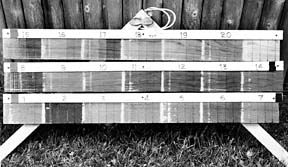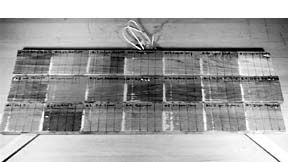Paint and varnish shouldn’t be too difficult to understand: They’re coatings you apply with a brush, roller or pad to protect or beautify the surface to which, you hope, they stick like fury.

However, in clear coverings alone there are so many variations on the themes, between standard varnishes, oil-based treatments, urethanes, pigmented stains, two-part versus one-part treatments, and so forth, that we at Practical Sailor sometimes get confused about the multiplicity of variations and capabilities we test. It is assumed, therefore, that it’s confusing for readers, too. So as an introduction to this varnish exposure update, we thought we’d review the four basic types of coatings that PS tests.
Perhaps most important are the continuing bottom paint tests. The tests, which require formidable effort, are going on almost continually. The annual reports on these paints appear usually in our March or April issues. In the most recent report, Micron Optima was rated best, but unfortunately that paint is still not available in the US, though it was supposed to appear this past summer. Pettit’s Trinidad SR and Interlux’s ACP Ultima and Micron CSC Extra (the last now called Micron Extra with Biolux) became the winners by default. Yes, it is confusing, but it ain’t our fault.
A second category of paint is topsides enamel. It has been tested occasionally, with the most recent report in the April, 1996 issue. Just underway is a new round of tests; because modern paints are so durable, the testing requires several years of exposure. In that 1996 report, Pettit EasyPoxy was the best one-part paint, but was bested by Awlgrip, Imron and Sterling—all two-part urethanes.
A third category of coatings involves teak treatments—mostly oils or stains intended to keep teak looking handsome. The best in recent years have been, if you like a matte finish, Cetol, with Armada and Woolsey Protective Wood Coating close behind; in more glossy treatments, Honey Teak had a slight edge over Smith & Company’s Five-Year Clear, with Armada MC2000 and C-Tech Marine’s Bristol Finish looking strong, but after lesser exposure times.
Confusing? Yep, still confusing. In fact, Marshall Nix of C-Tech Marine went to the trouble of documenting our test results for the last six years in a big table that shows the overlapping tenure and tenacity of no fewer than 31 teak treatments, including dead ends and false starts on our part. He points out, quite rightly, that while testing treatments to destruction is valuable, it also gets a bit ridiculous, because most people actually do maintain their teak coatings before they go completely down the tubes.
Finally, and getting to the point, there’s varnish, that traditional stuff that’s supposed to shine like a glitter ball in a dance hall. In the last several years, PS eschewed varnish tests in favor of the above-mentioned “teak treatment” products. However, reader reminders flowed in steadily, pointing out that many sailors, especially traditionalists, think that (1) varnish is worth the time and trouble, and (2) varnish has been greatly improved in recent years.
Spurred by the inquiries, Practical Sailor’s current varnish test commenced about 18 months ago. Using precisely matched teak boards, about a hundred brushes, abundant masking tape, a lot of sandpaper, a shelf-load of specified thinners (exactly as called for) and a few other sundry supplies, 20 kinds of varnish were applied in two-, three-, five- and seven-coat “takes.” On each board, a section was reserved, to be protected from exposure by a removable wood batten (in reality a common yardstick, but what would we be if we didn’t talk the talk?)

It took several weeks of intermittent but meticulous work to prepare the samples, another month to be sure the varnish was thoroughly dry. Most varnish skins dust-free in hours, but take much longer to cure; until there’s no more odor, the varnish is not yet finished hardening.
The sample boards, mounted on a simple frame, went outdoors on June 2, 2000. The frame was arranged to assure a half-day of full sunlight. The boards were examined in situ at intervals of one month (no discernible changes), two months (no change), and three months (some differences in color became evident).
Finally, after six months, the rack was brought indoors for a very close examination. The protective strips were removed to permit comparison of the original color and gloss with areas that had been exposed to sun and rain.
As was to be expected, a number of varnishes had failed in the two-coats sections. Another group was beginning to fail. An evaluation of the color was made and some color changes were mildly startling.
The results of that six-month exam are summarized in the chart on pages 12-13. Although regarded as an interim endeavor, the report was published in the March 2001 issue for those readers who regard varnish as needing attention at least every six months. This would be especially true for those in tropical climes, where varnish often is redone on a schedule that a northerner would regard as onerous.
After reassembly, the test rack went back outdoors to endure the sun and snow of a New England winter plus another spring of sun and rain. In June of this year, back in came the rack for another close examination.
If you’ve outlasted the preamble, what follows is a 12-month progress report. Here are notes of interest:
• Every two-coat section failed, indicating clearly that a hurry-up, skinny application results in a coat too thin to withstand even one summer sailing season in northern climes. West Marine’s Wood Pro was starting to fail, but that “breathable” finish may not meet the strict definition of “varnish.”
• Moving to the three-coat sections, six of the 20 had failed, with three others starting to fail. The six that failed were VC Systems Plus-5, Interlux’s Clipper, Epifanes’ Clear, Pettit’s Old Salem, Sears Poly Outdoor, and Absolute Coatings Last n’ Last. Starting to fail were West Marine Skipper, Pettit’s Hi-Build 2056 and Ultra Gold.
• In all cases, the five- and seven-coat sections remained intact.
•It is remarkable to see the differences in lightness and darkness, as well as the abrupt color variations in varnish applied to matched teak boards.
• Six of the samples have darkened considerably, to the point that most users would call unacceptable. The six are Z Spar’s Captain’s, West Marine’s Skipper, Epifanes’ Clear, Epifanes’ Wood Finish, Pettit’s Hi-Build, and Pettit’s Ultra Gold.
• If you’re interested in the varnish that is best at preserving the original light color of the teak, those that do it best are VC Systems Plus-5; Interlux’s Jet Speed and Clipper, Z Spar’s Captain’s and Flagship; US Paint’s AwlSpar; Cabot’s Oil-Based Poly, and Absolute Coating’s Last n’ Last.
•For gloss, many of these varnishes were not, comparatively speaking, very glossy to begin with. However, the shiniest after a year’s exposure are Interlux’s Interthane (the only two-part varnish in this test); West Marine’s Skipper; Epifanes’ Clear and Wood Finish, and Pettit’s Hi-Build and Old Salem.
• Worth a special note is Interlux’s Jet Speed, which although well-ranked after six months, went strangely very dull in 12 months. This varnish, a fast-drying mixture intended for quick overcoating, may be a good quick sealer, but cannot be recommended as a finish coat.
Conclusions (well, sort of)
It used to be quick and easy to test paint and varnish. Slap it on, wait six months or so, and the fading, the cracking, and flaking commenced. Remember how new car paint used to lose color and luster?

Today’s coatings, especially paint, are the subjects of intense chemical research. It’s big-money stuff. About a billion and a half gallons of paint are produced every year in the US.
It’s also true of varnishes. And the varnishes in this test seem to be lasting longer than expected even when measured against varnish of a half-dozen years ago. The great care taken with their workbench application may account for this.
In addition, the exposure also might be less severe than on a boat hatch or gunwale, where the sun gets a longer and more nearly perpendicular shot at the varnish, causing it to undergo more severe photolysis. (In Florida or the Caribbean, it’s certain that the deterioration would be much more rapid.)
Looking at the 20 varnishes in the chart, you’ll notice that some varnishes with outstanding qualities in one category seem to lose their luster when all categories are considered. You may covet a light color enough to put up with a varnish that doesn’t last the longest. You may put high gloss first. Or you may just want the varnish that protects the longest, color and gloss be damned.
It’s difficult when searching for a general rating method to combine the qualities of film integrity, gloss, and color. Certainly, for most varnish fans, those that don’t last very long wouldn’t earn any preference points.
The best that can be said at this juncture is that this varnish test has not yet progressed to the point where, for instance, the qualities of gloss, color and longevity can be singled up to identify three preferred varnishes.
However, it would appear that, barring anything unusual (like the Jet Speed losing its luster), the leaders at this point might be identified by finding the best meld of gloss, color, and the current condition of the remains of the 3-, 5- and 7-coat sections.
A review of the chart shows the leaders to be Interlux’s Interthane, which is, as noted above, the only two-part varnish, and Epifanes’ Wood Finish. This is on the basis of best gloss and the coatings’ integrity. Note also that those two have darkened the teak, as have the other four with excellent gloss ratings. It may be that if you want outstanding performance in gloss and coating integrity, you must accept some darkening. No varnish that retained a light color had an “excellent” gloss rating.
There was only one varnish that retained a light color and earned a “good” gloss rating—Interlux’s Schooner, although US Paint’s Awlspar was right behind. VC Systems’ Plus-5 might have made that list, except that the 2- and 3-coat sections had failed.
In our ceaseless search for a “final” ranking that will be of value to readers looking for the combination of qualities they prefer, the sample rack has been reassembled and placed outdoors for more wear and tear, courtesy of Mother Nature, air pollution, and passing birds. And guaranteed, the day we relaunch, a new varnish will be brought urgently to market.
Contacts- Absolute Coatings, 38 Portman Rd., New Rochelle, NY 10801; 914/636-0700; www.absolutecoatings.com. Cabot, 100 Hale St., Newburyport, MA 01950; 800/US-STAIN; www.cabot-corp.com. Epifanes North America, 58 Fore St., Portland, ME 04101; 207/775-1333; www.epifanes.com. Interlux Yacht Finishes, 2270 Morris Ave., Union, NJ 07083; 908/686-1300; 800/INTERLUX; www.yachtpaint.com. Pettit Paint, 36 Pine St., Rockaway, NJ 07866; 800/221-4466; www.kop-coat.com. Sears, Roebuck and Co., Hoffman Estates, IL 60179; 800/9 PAINTS; www.sears.com. Target Enterprises, PO Box 1582, Rutherford, NJ 07070; 800/752-9922. U.S. Paint, 831 S. 21st St., St. Louis, MO 63103; 314/621-0525; www.uspaint.com. West Marine, PO Box 50070, Watsonville, CA 95077; 800/262-8464; www.westmarine.com. Woolsey/Z-Spar (Kop-Coat Marine Group), 36 Pine St., Rockaway, NJ 07866; 800/221-4466; www.kop-coat.com.
Also With This Article
Click here to view the Varnish Value Guide.
































